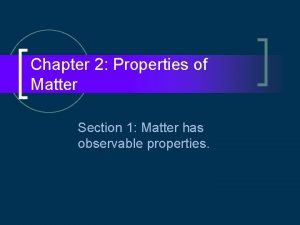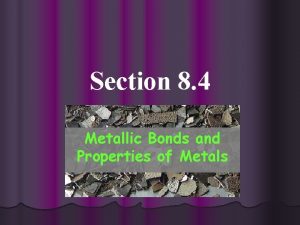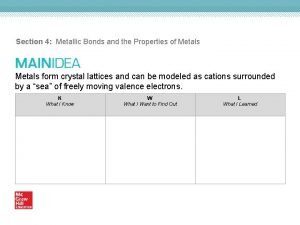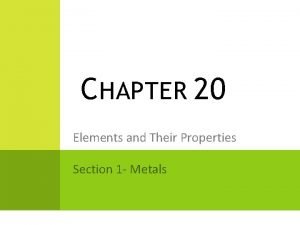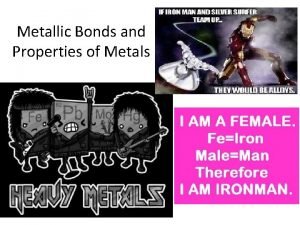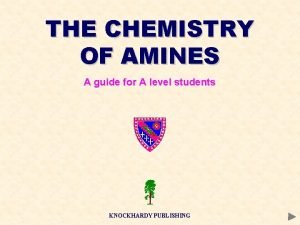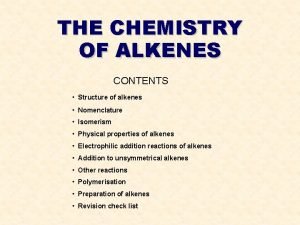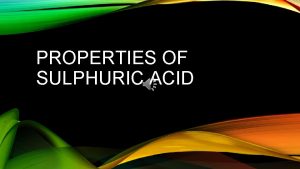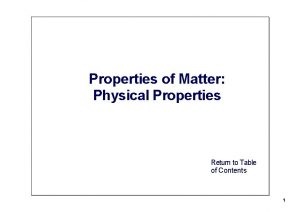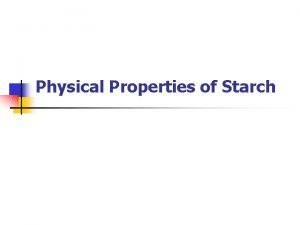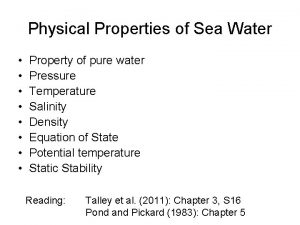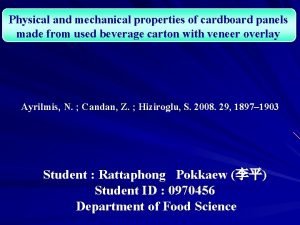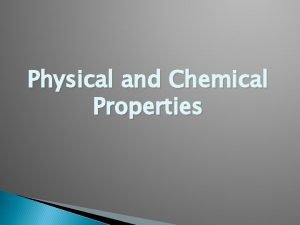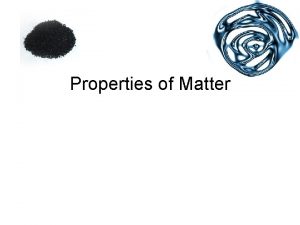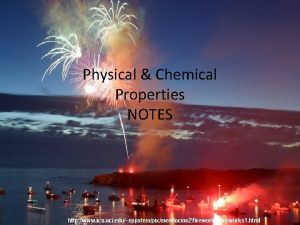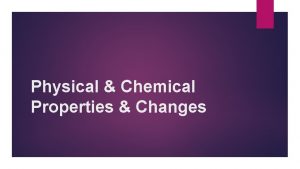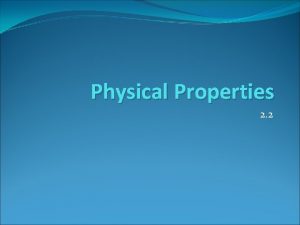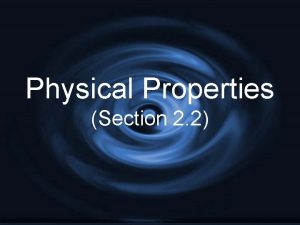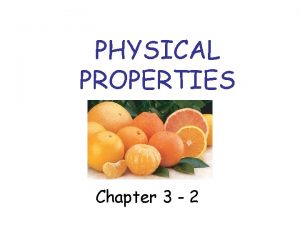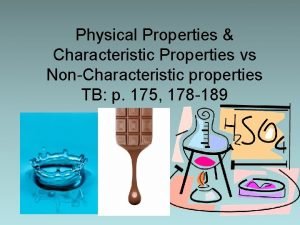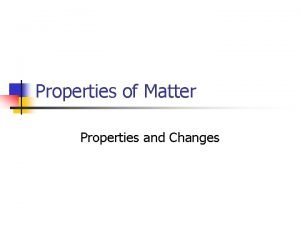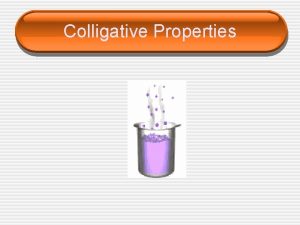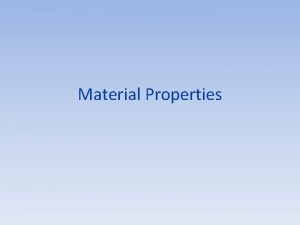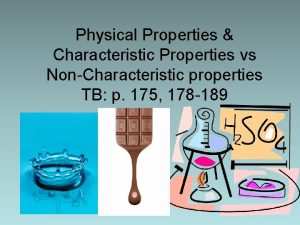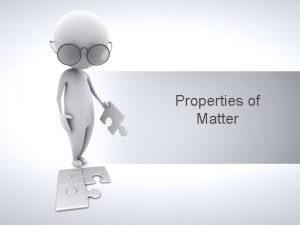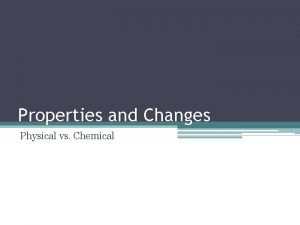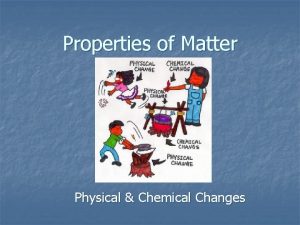Physical Properties Chapter 2 Section 2 Physical Properties
























- Slides: 24

Physical Properties Chapter 2 Section 2

Physical Properties � Physical Property – any characteristic of a material that can be observed or measured without changing the composition of the substances in the materials. ◦ ◦ ◦ ◦ Viscosity Conductivity Malleability Hardness Melting point Boiling point Density

Viscosity � Resistance to flowing ◦ The greater the viscosity = slower the liquid moves ◦ Thin liquids have low viscosity �Water �Vinegar ◦ Thick liquids have high viscosity �Honey �Corn Syrup

Viscosity � Why usually decreases when it is heated is viscosity important?

Conductivity �A material’s ability to allow heat to flow � Materials with high conductivity such as metals are called conductors � If a material is a good conductor of heat it is usually a good conductor of electricity

Malleability � The ability of a solid to be hammered without shattering. � Most metals are malleable.

Hardness � Compare the hardness of two materials by seeing which material can scratch the other. � Diamond is the hardest known material.

Melting and Boiling Points � Melting point: the temperature at which a substance changes from solid to liquid � Boiling point: the temperature at which a substance boils ◦ Water MP= 0°C ◦ Water BP = 100°C

Density � Density can be used to test the purity of a substance � Ratio of the mass of a substance to its volume � Equation for density D = M/V

Using Physical Properties � Physical properties are used to: ◦ Identify a material ◦ Choose a material for a specific purpose ◦ To separate the substances in a mixture

Separation Methods � Filtration – the process that separates materials based on the size of their particles � Distillation – a process that separates the substances in a solution based on their boiling points

Recognizing Physical Changes � Physical change – occurs when some of the properties of a material change but the substances in the material stay the same � Some physical changes can be reversed others cannot be reversed ◦ Examples of physical changes �Melting butter in a pan �Crumpling paper �Slicing a tomato �Braiding hair �Peeling an orange

Reviewing Concepts � List 5 examples of physical properties � Describe 3 uses of physical properties � Name two procedures that are used to separate mixtures � When you describe a liquid as thick, are you saying that it has high or low viscosity? � Explain why sharpening a pencil is a physical change. � What allows a mixture to be separated by distillation?

Chemical Properties Chapter 2 Section 3

Chemical Property � Any ability to produce a change in the composition of matter. � Can be observed only when the substances in a sample of matter are changing into different substances. � Examples: ◦ Flammability ◦ Reactivity

Flammability �A material’s ability to burn in the presence of oxygen. � Sometimes flammability is a desirable property (gasoline, firewood) � Other times flammability is not desirable (fabrics for pajamas)

Reactivity � How readily a substance combines chemically with other substances � Examples ◦ Oxygen – high reactivity ◦ Nitrogen – low reactivity

Chemical Change � Occurs when a substance reacts and forms one or more new substances � Three common types of evidence for a chemical change: 1. Change in color 2. Production of a gas 3. Formation of a precipitate

Change in Color � Examples: ◦ ◦ ◦ Leaves changing color in the fall Ripening of a banana peel Silver bracelet exposed to air darkens Match that burns turns black Copper changing when exposed to moist air (patina)

Change in Color A new copper roof has a reddish color An old copper roof has a greenish color

Production of a Gas � Carbon dioxide gas forms when vinegar is mixed with baking soda � Baking powder in a cake causes a cake to rise ◦ Baking soda and acids react when wet, cake bakes, bubbles of CO 2 expand, cake rises

Formation of a Precipitate � Precipitate – any solid that forms and separates from a liquid mixture � Example: curds in cottage cheese – form when an acid is added to milk

Is a Change Chemical or Physical? � Are different substances present after the change takes place? ◦ NO – change is PHYSICAL ◦ YES – change is CHEMICAL ◦ When matter undergoes a chemical change the composition of matter changes. ◦ When matter undergoes a physical change the composition of matter remains the same.

Reviewing Concepts � List three common types of evidence for a chemical change. � How do chemical changes differ from physical changes? � Gold and platinum are often used to make jewelry. What can you infer about the reactivity of these elements? � A piece of butter melts and then burns in a hot frying pan. Which of these changes is physical and which is chemical?
 Physical properties of ice cube
Physical properties of ice cube Chapter 10 section 1 meiosis worksheet answer key
Chapter 10 section 1 meiosis worksheet answer key Extensive vs intensive quantity
Extensive vs intensive quantity Buoyancyability
Buoyancyability Section 2 properties of matter
Section 2 properties of matter The two rows of elements that seem to be disconnected
The two rows of elements that seem to be disconnected Section 4 metallic bonds and the properties of metals
Section 4 metallic bonds and the properties of metals Section 4 metallic bonds and the properties of metals
Section 4 metallic bonds and the properties of metals Elements and their properties section 2 nonmetals
Elements and their properties section 2 nonmetals Brass metallic bond
Brass metallic bond Chapter 17 overview elements and their properties
Chapter 17 overview elements and their properties Half section view example
Half section view example Removed view
Removed view What is full section?
What is full section? Section 2 describing energy worksheet answers
Section 2 describing energy worksheet answers Amino acid optical isomers
Amino acid optical isomers Bromine test saturated or unsaturated
Bromine test saturated or unsaturated Physical properties of sulphuric acid
Physical properties of sulphuric acid 2 hydrogen 1 oxygen
2 hydrogen 1 oxygen A scientist performs an experiment, and an actor performs a
A scientist performs an experiment, and an actor performs a 5 starch properties
5 starch properties Salinity unit of measurement
Salinity unit of measurement Ideal properties of dental materials
Ideal properties of dental materials Lesson outline lesson 2 - physical properties answer key
Lesson outline lesson 2 - physical properties answer key Chemical properties of cardboard
Chemical properties of cardboard




